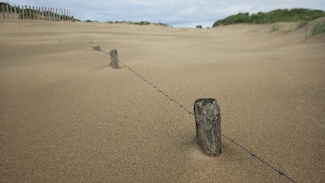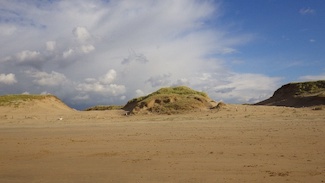U. van Buuren1, B. Arens2, M. Prins1
1 Vrije Universiteit Amsterdam,
2 Arens Bureau for Beach and Dune Research
Introduction
In the National Park Zuid Kennemerland, near the town of IJmuiden, five notches have been excavated in the foredune ridge to reactivate and promote aeolian transport of CaCO3-rich beach sand towards the inland dune system. This project is executed to rehabilitate the rare (Natura2000 protected) coastal dune biodiversity and increase coastal safety (Arens et al., 2015). In recent research of Van Hateren et al. (2020) it was concluded that it is possible to differentiate between transport processes (bedload vs. suspended load) based on combined grain size and shape data in aeolian sediments. Since the start of the rehabilitation project (2013-present) sand transported in suspension has been trapped and collected every two weeks in sandtraps custom made by Arens Bureau for Beach and Dune Research. In this research we investigate the spatial and temporal changes in sediment flux and composition (grain size-shape distributions, carbonate content) of the aeolian suspension load trapped during one of those years (2017), which is part of the ongoing PhD research project of Unze van Buuren.
Materials and Methods
The sandtraps (n=15) are distributed in four coast-parallel north-south transects (A to D, ~1 km in a N-S and ~1.2 km in an E-W direction). Samples are analysed by dynamic image analysis (n=204), which provides grain size and shape distribution data, and thermo gravimetric analysis (n=128) which determines the carbonate content. The grain shape parameter used here is the aspect ratio, defined as the ratio of the minimal to the maximal Feret diameter of a grain.
Results and conclusions
The sand flux recorded in the sand traps show large spatial (down-wind), temporal (inter-annual) changes. For instance, trap A1, located on the foredune, has an annual flux of 1573 gr, while C1, ~700 m downwind of the fore dune, has an annual flux of 16 gr.
The grain size and shape distributions show the existence of two subpopulations: a coarse population with a modal size of ~350 µm, with a relatively low aspect ratio, and a fine population with a mode at ~210 µm, with a relatively high aspect ratio. Down-wind changes in composition are reflected by a reduction of the proportional contribution of the coarse population (size sorting: down-wind fining) and a decrease of the aspect ratio of especially the coarse population (shape sorting: down-wind increase of proportion of platy/elongated grains).
The carbonate content has an average of 7.5 wt% varying on a spatial and temporal scale. Beach sediments (source) and dune sediments in the shallow subsurface underneath the traps show a significantly lower carbonate content.
To fully understand the (positive) effects of a reactivated dune system and considering the fact that shell fragments are predominately platy particles, our results clearly illustrate the importance of understanding aeolian suspension load transport and sorting processes.


Arens, B., Neijmeijer, T., Van Tongeren, O., 2016. Noordwestkern: effecten van ingrepen op dynamiek - resultaten monitoring 2013–2015. Tech. Rep. 2015.09, Arens BSDO, in Dutch.
Van Hateren, J.A., van Buuren, U., Arens, S.M., van Balen, R.T., Prins M.A., 2020. Identifying sediment transport mechanisms form grain size-shape distributions, applied to aeolian sediments. Earth Surf. Dynam., 8(2), 527-553
I. Surname1*, F.N. Another-Surname2 , Y. Next-Surname2
1 University Name, Country; 2 Organization Name, Country
* Corresponding author: mail.name@organization.org


